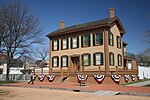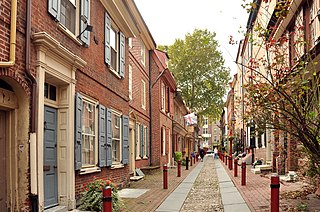List of landmarks
Individual landmarks
| Landmark Name | Image | Location | Built | Style | NRHP date |
|---|---|---|---|---|---|
| President Abraham Lincoln Home |  | 413 S 8th St | 1839 | August 18, 1971 | |
| Claus Grocery Store | 1700 S 11th St | 1905 | |||
| Constant & Groves Chevrolet Building | 425 S 4th St | ||||
| Adams House | 2315 Clear Lake Ave | ||||
| Allen Miller House |  | 511 S 8th St | |||
| Bell Miller Apartments | 835 S 6th St | ||||
| Booth-Grunendike Mansion | 500 S 6th St | c. 1870 | Second Empire | ||
| Bunn-Sankey House | 1001 S 6th St | 1883 | Queen Anne (Half-Timbered) | ||
| Bernard Stuve House |  | 526 S 7th St | 1869 | Italianate | |
| Camp Lincoln Commissary Building |  | 1301 N MacArthur Blvd | 1903 | November 13, 1984 | |
| Charles Arnold House |  | 810 E Jackson St | |||
| Charles Corneau House |  | 426 S 8th St | c. 1849 | ||
| Chatterton Place | 123/125 S 5th St | 1853 | Eclectic | ||
| Clarkson W. Freeman House |  | 704 W Monroe St | 1878 | Italianate, Carpenter-Gothic trim | September 29, 1980 |
| Congressman James M.Graham House |  | 413 S 7th St | 1862 | Italianate | May 1, 1989 |
| Cook House |  | 508 S 8th St | c. 1850 | ||
| Cranmer-Cook House | 926 South 7th Street | 1877 | Italianate | ||
| Dana-Thomas House |  | 301 E Lawrence Ave | 1902-1904 | Prairie Style | July 30, 1974 |
| Decker House | 303 S Glenwood Ave | 1864 | Italianate | ||
| Elijah Iles House |  | 628 S 7th St | 1837 | Greek Revival | February 23, 1978 |
| Executive Mansion |  | 410 E Jackson St | 1855 | Italianate | July 19, 1976 |
| Fisher-Latham Building |  | 111/113/115 North 6th St | 1850s | 19th Century classically-inspired | April 28, 2000 |
| George M. Brinkerhoff House |  | 1500 N 5th St | 1869 | Italianate | December 18, 1978 |
| Grant Store/Harts’ Block | 225 S 5th St | 1868 | Italianate | ||
| Harriet Dean House |  | 421 S 8th St | 1850s | ||
| Henson Robinson House |  | 520 S 8th St | 1863-1866 | ||
| Hoogland Center for the Arts | 420 S 6th St | ||||
| Illinois Hotel | 401 E Washington St | 1903 | |||
| Illinois State Armory | 107/111 E Monroe St | 1936 | Art Deco | ||
| Illinois State Capitol |  | 2nd & Capitol | 1868 - 1888 | Renaissance Revival,Second Empire | November 21, 1985 |
| Jessie K. DuBois House |  | 519 S 8th St | |||
| The INB Center The CILCO Building | 322 E Capitol Ave | 1924 | Classical Revival, Beaux Arts | ||
| James Morse House |  | 818 E Capitol Ave | 1855 | ||
| Jennings Ford Building |  | 431 S 4th St | |||
| John L. Lewis House |  | 1132 W Lawrence Ave | September 10, 1979 | ||
| Julia Sprigg House |  | 507 S 8th St | |||
| K-Mart / Kresge Building | 127/131 S 5th St | Art Deco | |||
| Kirlin Building | 107-111 S 7th St | 1889 | |||
| Lanphier Building | 419/421 E Adams St | c. 1870-1884 | |||
| Lincoln Colored Home |  | 427 S 12th St | 1904 | August 6, 1998 | |
| Lincoln-Herndon Law Office |  | 6th & Adams St | 1840-1841 | Greek Revival | August 29, 1978 |
| Lincoln Tomb |  | Oak Ridge Cemetery | 1869-1874 | October 15, 1966 | |
| Howard K. Weber House |  | 925 S 7th St | 1840s | Italianate | October 1, 1979 |
| Lyon / Rosenwald House |  | 413 S 8th St | 1850s | ||
| Nelson Building | 117 S 7th St | ||||
| Old South Town Theater Marque | 1110 S South Grand St | ||||
| Old State Capitol |  | One Old State Capitol Plaza | 1837 to 1853 | Greek Revival | October 15, 1966 |
| Old State House Inn | 101 E Adams St | ||||
| Pasfield House | 404 W Jackson Pkwy | 1896 | |||
| Price/Wheeler House |  | 618 S 7th St | 1899 | Classical Revival | February 14, 1985 |
| Rippon-Kinsella Home |  | 1317 N 3rd St | c. 1870 | Italianate | February 27, 1992 |
| Robert Bullard House | 1313 Leland Ave | 1906 | Prairie Style | ||
| Shutt House |  | 525 S 8th St | c. 1859 | ||
| Schnepp Block | 314 E Adams St | 1912 | |||
| Solomon Allen Barn | 530 S 8th St | ||||
| St. Nicholas Hotel |  | 400 E Jefferson St | 1855 | Georgian Revival | February 10, 1983 |
| The Wetterer-Hodde House | 1004 Williams St | ||||
| Vachel Lindsay Bridge |  | Lake Springfield | 1933-1934 | ||
| Vachel Lindsay Home |  | 603 S 5th St | 1848 | Greek Revival | November 11, 1971 |
| Virgil Hickox House |  | 518 E Capitol Ave | c. 1839 | March 5, 1982 | |
| William Beedle House |  | 411 S 8th St | 1840 | ||
| Witmer-Schuck Building | 630 E Washington St | 1867 | |||
| Zimmerman Paint Store Building | 417 E Adams St | c. 1860-1870 | |||




